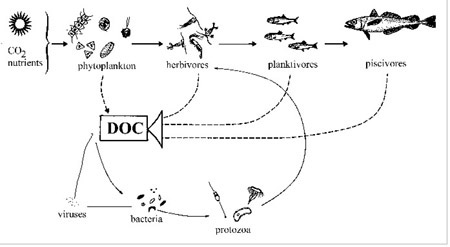|
Navigation
BOT4404
Main Page
FIU
Home
FIU
Marine Biology Home
Dept.
Biology Home
Frank
Jochem Home
E-Mail
|
The Role
of Algae in Aquatic Food Webs
-
Concept:
The „microbial food web“ complements the classical food chain
-
Pathways:
larger phytoplankton (>20 µm) are grazed by herbivorous crustacean
zooplankton, which in turn are grazed by planktivorous fish; small phytoplankton
is grazed by protozoa (as are bacteria), and protozoa are grazed by „herbivorous“
crustacean zooplankton
-
The Microbial
Loop: Dissolved organic carbon (DOC) produced
by algae (exudation) and during protozoan and zooplankton grazing is converted
into particulate biomass by bacteria and, thereby, re-channelled into the
food web. Viruses contribute to DOC production by algal and bacterial lysis

-
Size
classes of�phytoplankton:
-
Picoplankton:
0.2-2 µm
-
Nanoplankton:
2-20 µm
-
Microplankton:>20
µm
-
Pico-
and Nanophytoplankton are part of�the microbial food web
|
